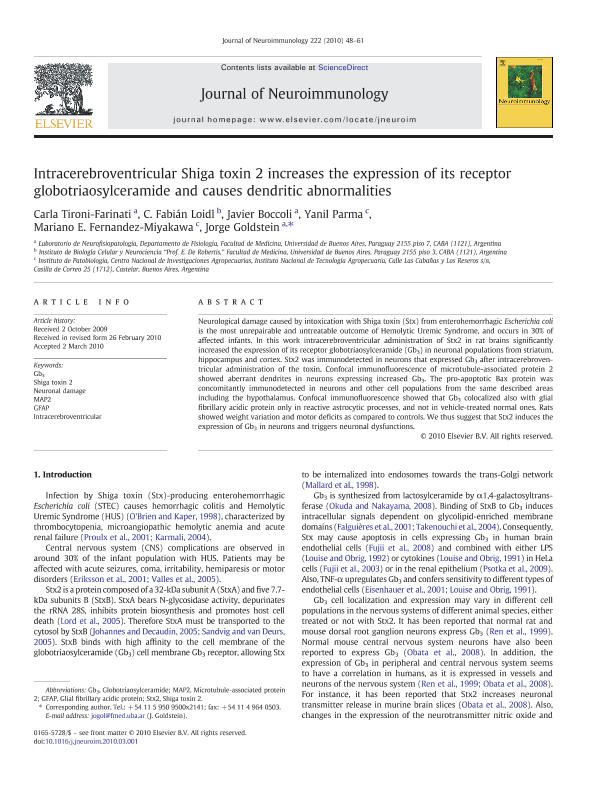Artículo
Intracerebroventricular Shiga toxin 2 increases the expression of its receptor globotriaosylceramide and causes dendritic abnormalities
Tironi Farinati, Alicia Carla Flavia ; Loidl, Cesar Fabian
; Loidl, Cesar Fabian ; Boccoli, Javier; Parma, Yanil Renee
; Boccoli, Javier; Parma, Yanil Renee ; Fernandez Miyakawa, Mariano Enrique
; Fernandez Miyakawa, Mariano Enrique ; Goldstein Raij, Jorge
; Goldstein Raij, Jorge
 ; Loidl, Cesar Fabian
; Loidl, Cesar Fabian ; Boccoli, Javier; Parma, Yanil Renee
; Boccoli, Javier; Parma, Yanil Renee ; Fernandez Miyakawa, Mariano Enrique
; Fernandez Miyakawa, Mariano Enrique ; Goldstein Raij, Jorge
; Goldstein Raij, Jorge
Fecha de publicación:
05/2010
Editorial:
Elsevier Science
Revista:
Journal Of Neuroimmunology
ISSN:
0165-5728
Idioma:
Inglés
Tipo de recurso:
Artículo publicado
Clasificación temática:
Resumen
Neurological damage caused by intoxication with Shiga toxin (Stx) from enterohemorrhagic Escherichia coli is the most unrepairable and untreatable outcome of Hemolytic Uremic Syndrome, and occurs in 30% of affected infants. In this work intracerebroventricular administration of Stx2 in rat brains significantly increased the expression of its receptor globotriaosylceramide (Gb3) in neuronal populations from striatum, hippocampus and cortex. Stx2 was immunodetected in neurons that expressed Gb3 after intracerebroventricular administration of the toxin. Confocal immunofluorescence of microtubule-associated protein 2 showed aberrant dendrites in neurons expressing increased Gb3. The pro-apoptotic Bax protein was concomitantly immunodetected in neurons and other cell populations from the same described areas including the hypothalamus. Confocal immunofluorescence showed that Gb3 colocalized also with glial fibrillary acidic protein only in reactive astrocytic processes, and not in vehicle-treated normal ones. Rats showed weight variation and motor deficits as compared to controls. We thus suggest that Stx2 induces the expression of Gb3 in neurons and triggers neuronal dysfunctions.
Palabras clave:
Gb3
,
Shiga Toxin 2
,
Neuronal Damage
,
Map2
,
Gfap
,
Intracerebroventricular
Archivos asociados
Licencia
Identificadores
Colecciones
Articulos(IBCN)
Articulos de INST.DE BIOLO.CEL.Y NEURCS."PROF.E.DE ROBERTIS"
Articulos de INST.DE BIOLO.CEL.Y NEURCS."PROF.E.DE ROBERTIS"
Articulos(OCA HOUSSAY)
Articulos de OFICINA DE COORDINACION ADMINISTRATIVA HOUSSAY
Articulos de OFICINA DE COORDINACION ADMINISTRATIVA HOUSSAY
Articulos(SEDE CENTRAL)
Articulos de SEDE CENTRAL
Articulos de SEDE CENTRAL
Citación
Tironi Farinati, Alicia Carla Flavia; Loidl, Cesar Fabian; Boccoli, Javier; Parma, Yanil Renee; Fernandez Miyakawa, Mariano Enrique; et al.; Intracerebroventricular Shiga toxin 2 increases the expression of its receptor globotriaosylceramide and causes dendritic abnormalities; Elsevier Science; Journal Of Neuroimmunology; 222; 1-2; 5-2010; 48-61
Compartir
Altmétricas



